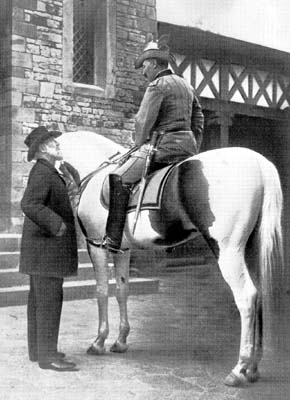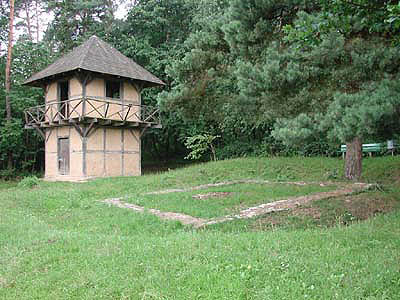
|
||||||||||||||||||||||||||||||||||||||||||||||||||||||||||||||||||||||||||||||||||||||||||
The Roman Empire was an important element in the founding of the foundation of the actual World in Europe. We have an important heritage on which our society continues to live and move. This hold Empire collapsed in 476 Rev JC (officially) with the deposition of the last Western Roman Emperor Romulus Augustule by the King of the Visigothc Odoacrer But he was already dead or dying for decades. Indeed the Roman Empire has attract lot of populations living on the fringes of its borders and then tried to enter in the Empire peacefully through games of treaties or in force by forcing the defenses
Why the attraction? The wealth supposed of Roman world who was known on the other side of the border, Roman way of life,etc etc
The Roman Way of Life " was a powerful mirror; But also skylark mirror the fantasy for the less fortunate who would leave a”backward” world for a world better but without pity This: does not remind you recent events in our contemporary World ? The Roman Limes .
We'll look at Limes of Central Europe and more specifically to the Rhenish Limes
This Limes of Central Europe is our Great Wall in Europe that if it is less well known than the Coliseum or other heavyweight architecture nevertheless pace some great Roman monument currently known But we plunge again in history to see how this work was created. History On September 9th 31 (BC) Octave defeated Egyptian fleet of Antony and Cleopatra at Actium and in 29 BC he defeated his latest enemies. In -27 BC he received the title of Augustus name by which he is known today. Augustus wants to concentrate all powers in his hands
The sacred and divine power but also political and military. He received the titles of Great Pontife and Augustus for the sacred and divine powers and that of imperator under which ranks above all generals for military powers
In response to the civil war that has shaken Rome the end of the first century before Christ requires an extensive reorganization of powers. Auguste seeks to bring stability and peace within the Roman world and you also secure its borders. To do this it is responsible borders by agreements with neighbouring kingdoms.
However, this policy of consolidation experiencing a serious setback in 9 Rev JC when three regions were massacred in the Forest of Teutenbourg
Exhausted August decide to withdraw its troops on the left bank of the Rhine. He then decided to set the frontiers of the Roman world whether in Europe to Africa or Asia But all his successors except Tiberius do not respect this point Roman armies will go forward
Claude begins the conquest of Britain and its successors until the end of the first century after Christ will extend even further the Roman domination in Germany
In Germany (Province of Germany) from the reign of Claude begins on the construction of a series of forts linked together by a road. It is the via Claudia Augusta that through the Brenner Pass directly linking this province to Italy But one day Sometimes the maximum expansion is achieved and that the emperor decided to stop.
It is therefore now to fix their borders and to defend against invaders The Emperor who decides whem is Hadrian which take back an hold plan ofs 50-year-old . In fact is Domitien who is the father of is idea.
The border will be fixed by a wall or limes; So in the middle of the II° century AD there were 4000 kilometers of fortifications to the 4 corners of the Empire But before the study of limes a little lesson of latin The Romans have different terms to designate the boundaries of the empire as political or geographical We find the terms and finis and terminus on the one hand and the term limes and ripas and the other hand The terms Finis or terminus Imperii means the area of political and economic influence that is usually larger than the area set by the Limes or Ripa Imperii We have two terms one juridical and the other economic to talk upon the relations of the Empire with these neighbouring peoples and two other more concrete terms that mark on the ground geographical boundaries rather than the area of influence of the Roman World . These concepts should not be confused A limes is a piece of work that can be seen on the ground. While the area of influence is more subtle This is an Pax Romana area where peoples mostly the elite imitate the roman “modus vivendi” The Limes
Definition
We will discover the Rhine’s Limes running in Central Europe between the Rhine and Danube. In military term Limes is a border demarcated by the defensive settlement crisscrossed by roads Sometimes the Limes uses either natural boundaries such as rivers, the mountains or sometimes traverse a plain in the middle. In a desert oases are strategic points. This network is based on a mesh which includes tours strong point like forts and roads It serves as a bell because in this networking we found colonies of veterans who have obtained a piece of land as a gift during their demobilization burden to them to defend
History
This network is being put in place since the time of Germanicus , Caligula father and is then continued by Domitien who undertakes a network of building watchtowers Hadrian transforms all in a fortified line which was slightly modified by Antoninus the pious The German Limes is very different from other limes .While African Limes (Mauretania Césarienne, Numidia) was only a vague line go through the mountains , Syrian Limes (Judea), was based on oasis , the Dacia, and Germania Limes was a strong fortified network based on a powerful line of forts and towns connected These Limes will not be built by a single jet but will undergo several phases of construction, which will see the building of 150 forts and more than 900 towers. The various phases of construction First phase between +90 and +100 AC JC. The Limes is certified by one. deforested area with a road patrol and wooden towers who watch the surrounding areas. Second phase +120 Reinforcement with a palisade in oak trunks.
Third phase +150 / 160 JC
Moving to the East The defence system is maintained and reinforced by watchtowers in wood
Fourth phase +170 Rev JC
The wooden towers are replaced with stone towers and a moat is dug forward. The spoil this gap can build an embankment that complements and efficiently replaces fences. By place a stone wall began to be built in particular Raetian . Alongside of this appear watchtowers which are located at distances allow sending messages. The Romans also built in the space forts for 1000 soldiers and small forts that must watch local traffic.  Description of Rhenish Limes Description of Rhenish Limes 
Since 2005 is an Unesco World Heritage Site This border has been the subject of significant archaeological work in the late nineteenth century and still continuing to be maintained restored and studied. The German authorities have highlighted monuments with appropriate signage and political reconstruction of the towers and forts
Founded in 1982 the Reichs-Limeskommission was led by the historian Mommsen and she had in the person of the Kaiser William II a big support
He order the reconstruction of the Roman camp of the Sallburg. This Reich-Limeskomission has set up a system of slicing limes and numbering of buildings that are still used today To do this was the limes to its origin divided into 5 sectors themselves divided into 3 sectors with a current numbering from west to east
Section 1 includes the Limes between Rhine and Lahn
Section 2 goes to rivers Lahn Ahr. And so on up to the last section of 15 who reached the Danube The towers are identified through a number reflecting the sector and the position and the 1 ° turn is the WP 1 / 1 The watchtower No. 1 is located Rheinbrohl in Rhineland-Palatinate (caput limitis) and the last 15/47 . As the numbering date of the 1892 new sites are marked with the letter minuscule (a) The Fortifications built The limes in the Federal Republic of Germany is a monument, which is clearly marked. The panel has brown color and resumed in white letters on behalf Deutch Limes Strasse and the logo represents a watchtower in silhouette. The committee that manages the monument organizes festivals and events to promote it. Now let's see the different types of construction There are 6 versions The vallum
It is a gap that has been dug along the entire length of the border and whose land rejected to the West as a land full of supporting a walkway on which circulates soldiers. It is the most primitive form of Limes
The palisade Wood
On the vallum thereafter was erected a wooden palisade to irritate potential invaders
Watchtowers and stone wall in continue
The German lime consists of a series of watchtower some of which have been reconstructed or on their place of origin or in the vicinity
All these tours are different I will not list all the towers were reconstructed Below is a series of pictures representing the main towers rebuilt at the initiative of the German commission. Take advantage of the holiday if you are in Germany to follow this route The strongpoints and the forts
The limes is after the towers marked by irregular strongpoints and forts that housed cohorts of infantrymen or cavalries alae. These troops could in time record reach the the threat point Sometimes the German authorities have reconstituted these barracks establishing a museum or archaeological park capturing the lives of troops under the Roman empire
We find three major museums that have been rebuilt at the same place in the Roman ruins the most important thing is the most famous being the Saalburg. Som other majors museums were created but the list is far from exhaustive The Museum Park Xanten the Dutch and Belgian borders The Parc de la Sallburg the oldest near Frankfurt am Main Pics of a some watchtowers rebuilts
The Romans barracks
PHOTOSCOPES DES FORTS ET TOURS DU LIMES
|
|
Droit d’auteur La plupart des photographies publiées sur ce site sont la propriété exclusive de © Claude Balmefrezol Elles peuvent être reproduites pour une utilisation personnelle, mais l’autorisation préalable de leur auteur est nécessaire pour être exploitées dans un autre cadre (site web publications etc) Les sources des autres documents et illustrations sont mentionnées quand elles sont connues. Si une de ces pièces est protégée et que sa présence dans ces pages pose problème, elle sera retirée sur simple demande. Principaux Collaborateurs:
Nb
de visiteurs:7890107 Nb
de visiteurs aujourd'hui:1527 Nb
de connectés:43 | ||||||||||||||||||||||||||||||||||||||||||||||||||||||||||||||||||||||||||||||||||||||||








.jpg)














.jpg)











